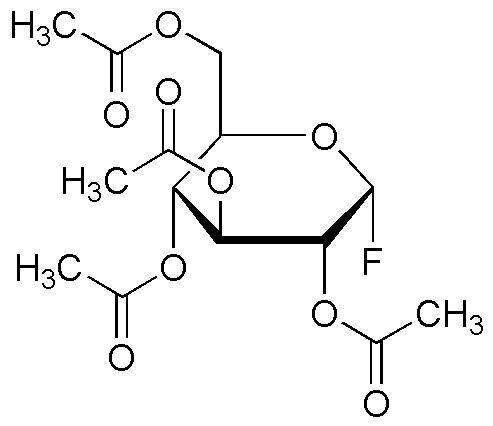Acetofluoro-a-D-glucose is widely utilized in research focused on:
- Pharmaceutical Development: This compound serves as a valuable intermediate in the synthesis of various pharmaceuticals, particularly those targeting metabolic disorders. Its unique fluorinated structure enhances bioactivity and selectivity.
- Diagnostic Imaging: Due to its fluorine content, it can be used in the development of imaging agents for PET scans, allowing for better visualization of metabolic processes in the body.
- Biochemical Research: Researchers use it to study carbohydrate metabolism and enzyme interactions, providing insights into cellular processes and potential therapeutic targets.
- Food Industry: Its derivatives can be employed as sweeteners or flavor enhancers, offering a low-calorie alternative while maintaining desirable taste profiles.
- Material Science: The compound's properties make it suitable for developing new materials with enhanced chemical resistance and stability, which can be beneficial in coatings and packaging applications.
General Information
Properties
Safety and Regulations
Applications
Acetofluoro-a-D-glucose is widely utilized in research focused on:
- Pharmaceutical Development: This compound serves as a valuable intermediate in the synthesis of various pharmaceuticals, particularly those targeting metabolic disorders. Its unique fluorinated structure enhances bioactivity and selectivity.
- Diagnostic Imaging: Due to its fluorine content, it can be used in the development of imaging agents for PET scans, allowing for better visualization of metabolic processes in the body.
- Biochemical Research: Researchers use it to study carbohydrate metabolism and enzyme interactions, providing insights into cellular processes and potential therapeutic targets.
- Food Industry: Its derivatives can be employed as sweeteners or flavor enhancers, offering a low-calorie alternative while maintaining desirable taste profiles.
- Material Science: The compound's properties make it suitable for developing new materials with enhanced chemical resistance and stability, which can be beneficial in coatings and packaging applications.
Documents
Safety Data Sheets (SDS)
The SDS provides comprehensive safety information on handling, storage, and disposal of the product.
Product Specification (PS)
The PS provides a comprehensive breakdown of the product’s properties, including chemical composition, physical state, purity, and storage requirements. It also details acceptable quality ranges and the product's intended applications.
Certificates of Analysis (COA)
Search for Certificates of Analysis (COA) by entering the products Lot Number. Lot and Batch Numbers can be found on a product’s label following the words ‘Lot’ or ‘Batch’.
*Catalog Number
*Lot Number
Certificates Of Origin (COO)
This COO confirms the country where the product was manufactured, and also details the materials and components used in it and whether it is derived from natural, synthetic, or other specific sources. This certificate may be required for customs, trade, and regulatory compliance.
*Catalog Number
*Lot Number
Safety Data Sheets (SDS)
The SDS provides comprehensive safety information on handling, storage, and disposal of the product.
DownloadProduct Specification (PS)
The PS provides a comprehensive breakdown of the product’s properties, including chemical composition, physical state, purity, and storage requirements. It also details acceptable quality ranges and the product's intended applications.
DownloadCertificates of Analysis (COA)
Search for Certificates of Analysis (COA) by entering the products Lot Number. Lot and Batch Numbers can be found on a product’s label following the words ‘Lot’ or ‘Batch’.
*Catalog Number
*Lot Number
Certificates Of Origin (COO)
This COO confirms the country where the product was manufactured, and also details the materials and components used in it and whether it is derived from natural, synthetic, or other specific sources. This certificate may be required for customs, trade, and regulatory compliance.


